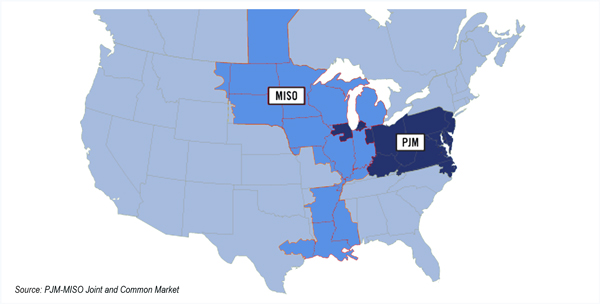By Amanda Durish Cook
MISO and PJM are seeking to hammer out new joint operating agreement language that would allow accelerated approval of short-term projects intended to relieve congestion at the RTOs’ seams before advancing further on a joint study that would identify potential projects.
MISO engineer Adam Solomon said that while the RTOs continue to work on the language detailing joint targeted market efficiency projects (TMEPs), the JOA needs to have a vetted process in place before project selection begins.
“We should really have the JOA language worked out before we push further into the study,” PJM engineer Alex Worcester agreed during a July 29 meeting of the MISO-PJM Interregional Planning Stakeholder Advisory Committee (IPSAC).
Targeted MEPs will differ from ordinary MEPs, which undergo a “longer and more rigorous” review that combines regional approval, modeling and analysis, and a review timeline. MEP rules may also be changing as a result of a FERC order requiring the RTOs to revise their interregional approval processes. (See MISO, PJM Working to Comply with NIPSCO Order.)
The two RTOs are currently evaluating 13 potential small projects in Illinois, Indiana, Michigan and Ohio.
“We’re really looking for the small, low-cost, short lead time projects that alleviate historical congestion at the seam,” Worcester said.
“We’re reviewing the upgrades and we’re working to ensure they’re effective and alleviate congestion,” Solomon said.
Officials from both RTOs said construction of the small projects could begin before the end of the year. That would require a special approval process developed within “a very tight timeline,” said Worcester, adding that the JOA should set out a simple method for TMEP approval.
The JOA stipulates that TMEPs must be in service within three years and cost less than $20 million. Projects exceeding the cap would move to the MEP classification. Because of the near-term nature of TMEPs, inflation rates will not be factored into the cost-benefit calculation.
MISO and PJM also propose to replace the current 1:1 cost-benefit ratio with a requirement that TMEPs produce enough benefits to cover their costs within four years.
“It’s a pretty high hurdle for these projects to pass,” Worcester said. “It’s consistent with our goal of having high-impact projects.”
To determine if a project meets the cost-benefit metric, the RTOs will rely on three years of historical congestion data to project a future case adjusted by market-to-market payments.
The new cost-benefit approach will “avoid complicated analysis,” said Worcester, who added that he could further illustrate the approach at the Aug. 26 IPSAC meeting.
The RTOs also want to be able to discount historical congestion at flowgates — used to determine TMEP project eligibility — by factoring in congestion hedges or auction revenue rights.
Worcester said that flowgates have an average of 30 to 40% of their flow hedged, but some flowgates have 100% hedging while others have zero. “What we’ve seen is a lot of variability from flowgate to flowgate,” he said.
Stakeholders are asked to provide feedback on the proposed TMEP language by Aug. 12. Final draft language will be presented at the Aug. 26 meeting.
“We’re making good progress toward getting this filed,” Worcester said.





